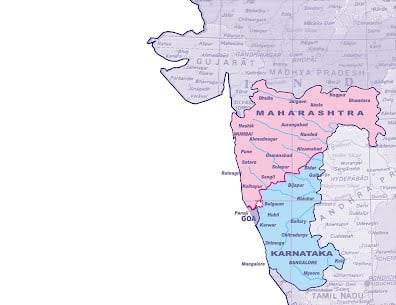What’s in today’s article?
- Why in news?
- What is Maharashtra-Karnataka border dispute?
- Historical Background of border dispute between Maharashtra and Karnataka
- What was the aim of Mahajan Commission?
- How are disputes between states resolved in India?
Why in news?
- The border dispute between Maharashtra and Karnataka is intensifying, with both states hardening their stance.
- Recently, both Houses of the Maharashtra Assembly passed a unanimous resolution to support a legal battle to resolve the dispute.
What is Maharashtra-Karnataka border dispute?
Historical Background of border dispute between Maharashtra and Karnataka:
- The Maharashtra and Karnataka boundary dispute has its origins in the reorganisation of states along linguistic lines via the State Reorganisation Act, 1956.
- This Act, which took effect from 1 November, 1956, divided states on linguistic lines.
- Since its creation on May 1, 1960, Maharashtra has claimed that 865 villages, including Belagavi (then Belgaum), Carvar and Nipani, should be merged into Maharashtra.
- Maharashtra claims that these are the regions where Marathi is the dominant language, should remain in Maharashtra.
- Karnataka, however, has refused to part with its territory.
What was the aim of Mahajan Commission?
- On October 25, 1966, the Centre constituted the Mahajan Commission headed by the then Supreme Court Chief Justice Meher Chand Mahajan, at the insistence of Maharashtra.
- Commission’s recommendations –
- While rejecting Maharashtra’s claim over Belagavi (then Belgaum), the commission recommended 247 villages/places, including Jatt, Akkalkote and Solapur, to be made part of Karnataka.
- It also declared 264 villages /places, including Nippani, Khanapur and Nandagad, to be made part of Maharashtra.
- However, the commission’s report was outrightly rejected by Maharashtra, and in 2004, it moved the Supreme Court.
How are disputes between states resolved in India?
Centre as a neutral mediator
- Attempts are often made to resolve inter-state disputes with the cooperation of both sides, with the Centre working as a facilitator or a neutral mediator.
- For example, in current case between Maharashtra and Karnataka, Union Home Minister met both the Chief Ministers and asked them to form a six-member team to address all boundary issues.
- If issues are resolved amicably, Parliament can bring a law to alter state boundaries.
- E.g., Bihar-Uttar Pradesh (Alteration of Boundaries) Act of 1968 and the Haryana-Uttar Pradesh (Alteration of Boundaries) Act of 1979 was brought in similar fashion.
Judicial redressal
- The Supreme Court in its original jurisdiction decides imputes between states.
- Article 131 of the Constitution allows SC to have original jurisdiction in any dispute:
- between the Government of India and one or more States; or
- between the Government of India and any State or States on one side and one or more other States on the other; or
- between two or more States.
- Article 131 of the Constitution allows SC to have original jurisdiction in any dispute:
Through Inter-state Council
- Article 263 of the Constitution gives powers to the President to set up an Inter-state Council for resolution of disputes between states.
- The Council is envisaged as a forum for discussion between the states and the Centre.
- In 1988, the Sarkaria Commission suggested that the Council should exist as a permanent body, and in 1990 it came into existence through a Presidential Order.
- In 2021, the Centre reconstituted the Inter-state Council and the body now has 10 Union Ministers as permanent invitees.
- The standing committee of the Council has been reconstituted with Home Minister as Chairman.
Q1) With how many States does Maharashtra share its boundary?
Maharashtra is bordered by Madhya Pradesh to the north, Chhattisgarh to the east, Telangana to the southeast, Karnataka to the south and Goa to the southwest. Gujarat lies to the northwest, with the Union territory of Dadra and Nagar Haveli sandwiched between the borders.
Q2) What was the main objective of Sarkaria Commission?
The main objective of the Sarkaria Commission was to examine the relationship and balance of power between state and central governments and recommend changes to strengthen cooperative federalism.
Source: How are disputes among states resolved in India? | Time Of India | India Today | The Hindu
Last updated on June, 2025
→ UPSC Notification 2025 was released on 22nd January 2025.
→ UPSC Prelims Result 2025 is out now for the CSE held on 25 May 2025.
→ UPSC Prelims Question Paper 2025 and Unofficial Prelims Answer Key 2025 are available now.
→ UPSC Calendar 2026 is released on 15th May, 2025.
→ The UPSC Vacancy 2025 were released 1129, out of which 979 were for UPSC CSE and remaining 150 are for UPSC IFoS.
→ UPSC Mains 2025 will be conducted on 22nd August 2025.
→ UPSC Prelims 2026 will be conducted on 24th May, 2026 & UPSC Mains 2026 will be conducted on 21st August 2026.
→ The UPSC Selection Process is of 3 stages-Prelims, Mains and Interview.
→ UPSC Result 2024 is released with latest UPSC Marksheet 2024. Check Now!
→ UPSC Toppers List 2024 is released now. Shakti Dubey is UPSC AIR 1 2024 Topper.
→ Also check Best IAS Coaching in Delhi
























